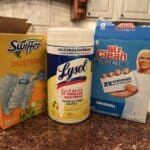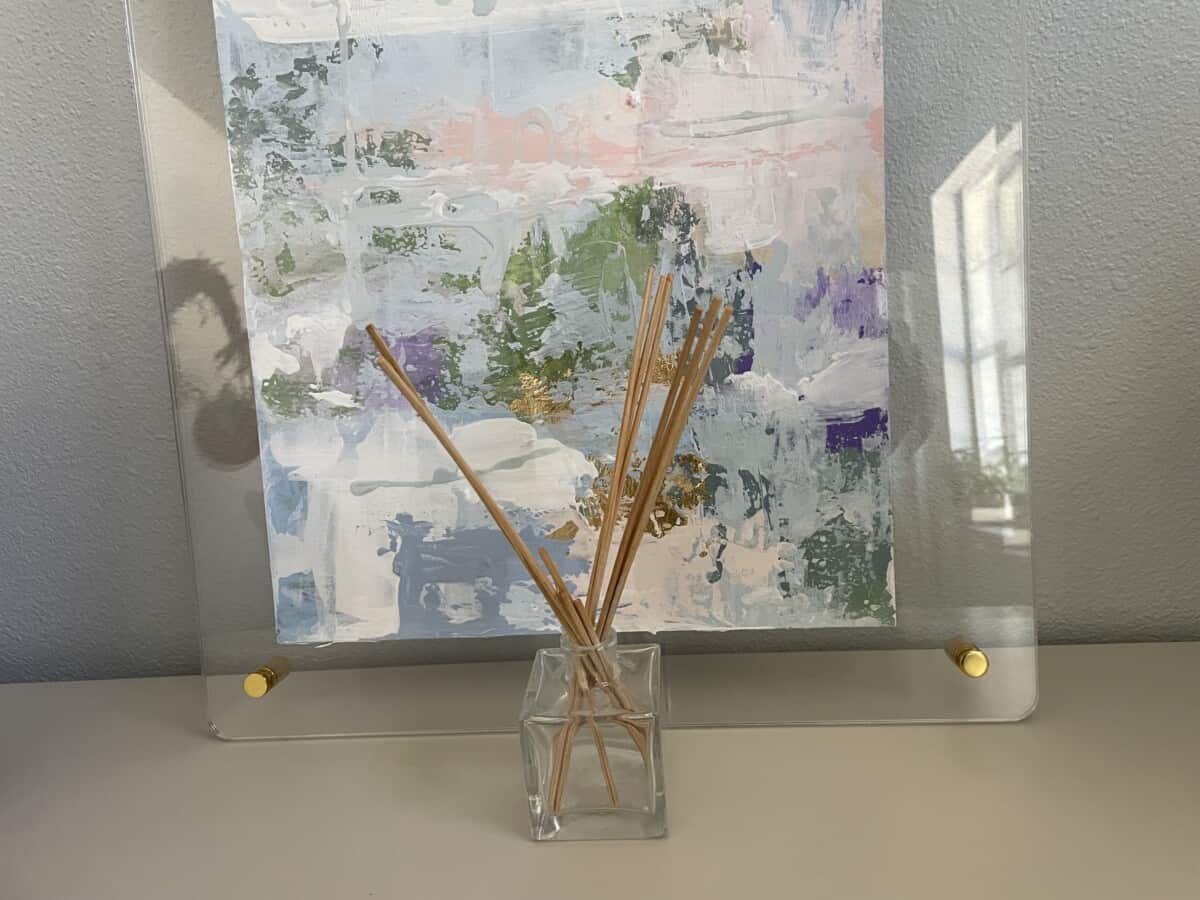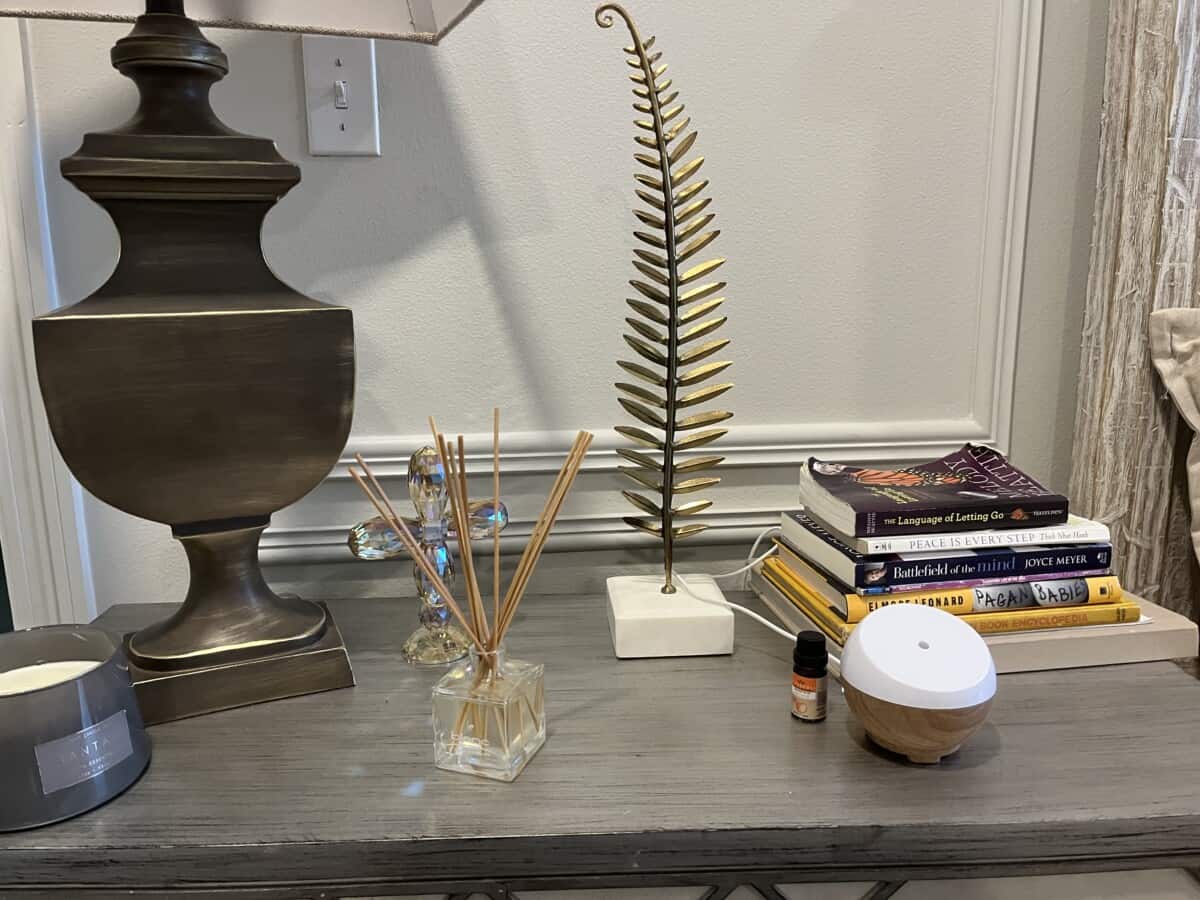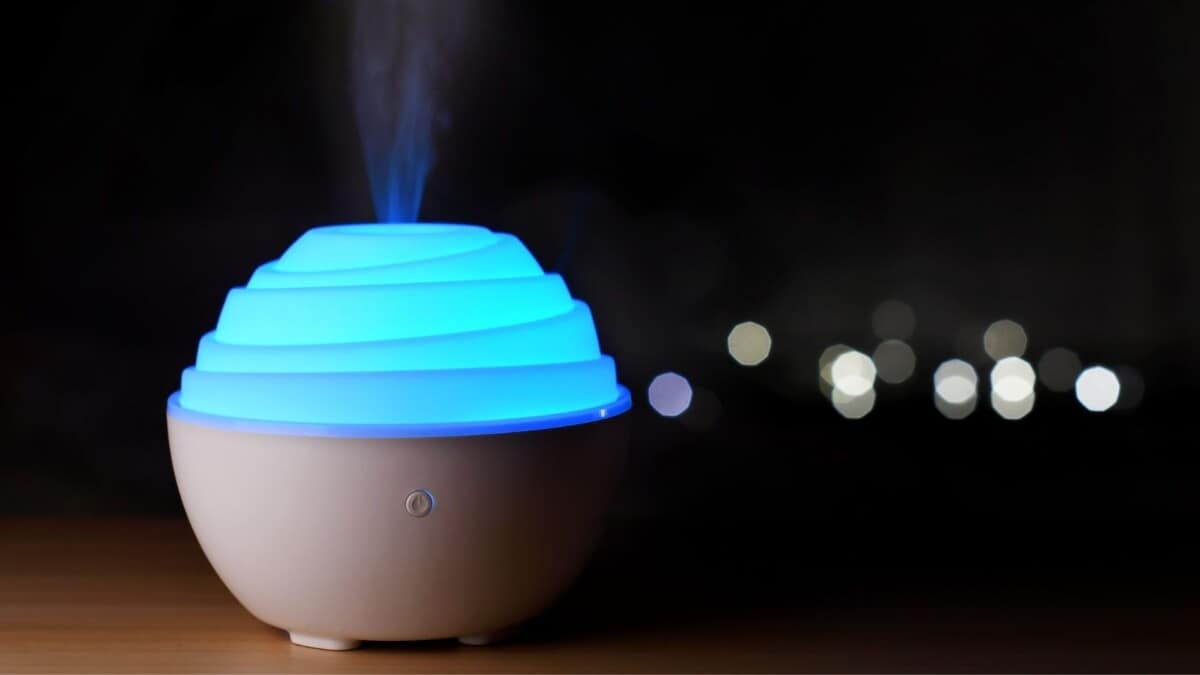If you’re like me, you love to have your home filled with the fresh scents of essential oils. They make your home smell amazing and can help you relax after a long day. But can you use them in a reed oil diffuser?
You can use essential oils in a reed diffuser, but you must thin them so they can be absorbed and flow up the reeds. Reed oil diffusers are a popular way to enjoy the benefits of essential oils. They are simple to use and can be placed almost anywhere in your home.
You can use your favorite essential oil in a reed diffuser by following a simple recipe. This blog post will discuss the best essential oils to use in a reed oil diffuser and how to use them. We will also provide some tips on how to get the most out of your reed oil diffuser.

What is a reed diffuser?
Reed diffusers are a great way to disperse aromatic scents through evaporation in a small space. It’s a device that uses reed diffuser oils to disperse scent into the air.
It works by using small wooden or bamboo reeds submerged in oil. The reeds absorb the oil and then release it slowly into the air. If you are looking for a diffuser that emits a stronger scent, then you should consider using an essential oil diffuser.
However, if you are looking for a diffuser with a more subtle scent, you should use a reed diffuser. Both types of diffusers have their own benefits and drawbacks. You can choose which type of diffuser is right for you based on your needs and preferences.
Reed diffuser oils
Reed diffuser oils are specially designed for use in reed diffusers. They are typically made up of a blend of essential oils and carrier oils. The essential oils provide therapeutic benefits, while the carrier oils dilute the mixture so the reeds can absorb it.
Reed diffuser oils come in various scents, so you can find one that suits your needs. If you check out the ingredients in a store-bought reed diffuser oil, you will see that it contains water, essential oil, alcohol, and some neutral oils called base oils or carrier oils.
Some products also have preservatives and perfumes mixed with them. Reed oils always use a carrier oil to help the essential oils get absorbed into the reeds.
This enhances the dispersal action and ensures that your reed diffuser’s oil lasts longer. Essential oils are volatile on their own, and carrier oils or neutral oils prevent them from evaporating too quickly.
On the other hand, electric or ultrasonic essential oil diffusers require pure essential oils mixed with water to create a fine mist or spray that covers a larger area.
What Oil is best for reed diffusers?
The oil that works best for reed diffusers is a mixture of carrier oil and pure essential oil.
Carrier oils (also called base oils) dilute the essential oils and enable the reed diffuser sticks to absorb the essential oils better. They are odorless, which means that they do not interfere with the essential oil’s fragrance.
Essential oils are derived from seeds, fruits, flowers, stems, leaves, bark, or other plant parts. They contain all of the beneficial properties of the plant and can be used for a variety of health benefits.
Many people make their own reed oil for their reed diffusers. Here is my favorite recipe derived from Llewellyn’s Complete Book of Essential Oils:
Items
- Decorative glass bottle/porcelain jar or container. Make sure it has a narrow neck.
- Reed diffuser sticks
- Carrier oil – I used sunflower oil. I find sunflower oil to be much thinner than most carrier oils. This helps it mix with the essential oils easily. (I have discussed the best carrier oils to use in reed diffusers later in this guide).
- Essential oil – I used lavender oil
Method
- Pour ¼ cup of carrier oil into the jar.
- Add 2 tsp or around 10-15 drops of the essential oil to the carrier oil.
- Swirl the jar to mix the oils.
- Place the reeds in the jar. You can also turn the reeds upside down to get them to soak more oil.
- After that leave them to soak the oil.
- Flip them over once a day or once in two to three days to help disperse more scent.
- Over time, replenish the jar with oils.
- Also, change the reed diffuser sticks from time to time.

Can you use reed diffuser oil in an aromatherapy diffuser?
So, to answer the question: can you use reed diffuser oil in an electric aromatherapy oil diffuser? It depends on what the reed diffuser oil contains.
Many commercial reed diffuser oils are made without essential oils. Instead, they use perfumes or synthetic or manufactured chemical fragrances. Some also contain mineral oils and di-propylene glycol. These ingredients are not suitable for use in electric or ultrasonic diffusers.
3 Reasons Why You Should Not Use Reed Diffuser Oil in Aromatherapy Diffusers
Practicing safety is paramount when you use any type of aromatherapy diffuser. Here are some reasons why you should not use reed diffuser oil in an electric oil diffuser:
#1. Fire hazards
Oils are not entirely harmless. They can cause burns if not handled properly. There have been cases where people have got burnt from the spray from vaporizers and diffusers when using improper oil or not practicing safety.
#2. Electrical hazards
Oils used in reed diffusers often contain heavy perfume oils or carrier oils. If you plug in a vaporizer or electric diffuser with this ‘wrong oil,’ it could cause short-circuit and lead to electrical issues in your entire house’s circuit.
My neighbor’s daughter filled her mosquito repellent vaporizer with neem oil that she had mixed with some essential oils. She plugged it in, thinking she was in for a peaceful night without mosquitoes. However, in the middle of the night, the heavy neem oil overloaded the circuit, and the entire house was plunged into darkness. My neighbor had to spend several hundred dollars replacing the burnt circuit.
#3. You won’t reap the therapeutic benefits
Most people use aromatherapy diffusers for the therapeutic benefits of essential oils. Reed oils bought from the store do not always contain pure essential oils. This could lead to a waste of money, and you won’t reap any health benefits from using them.
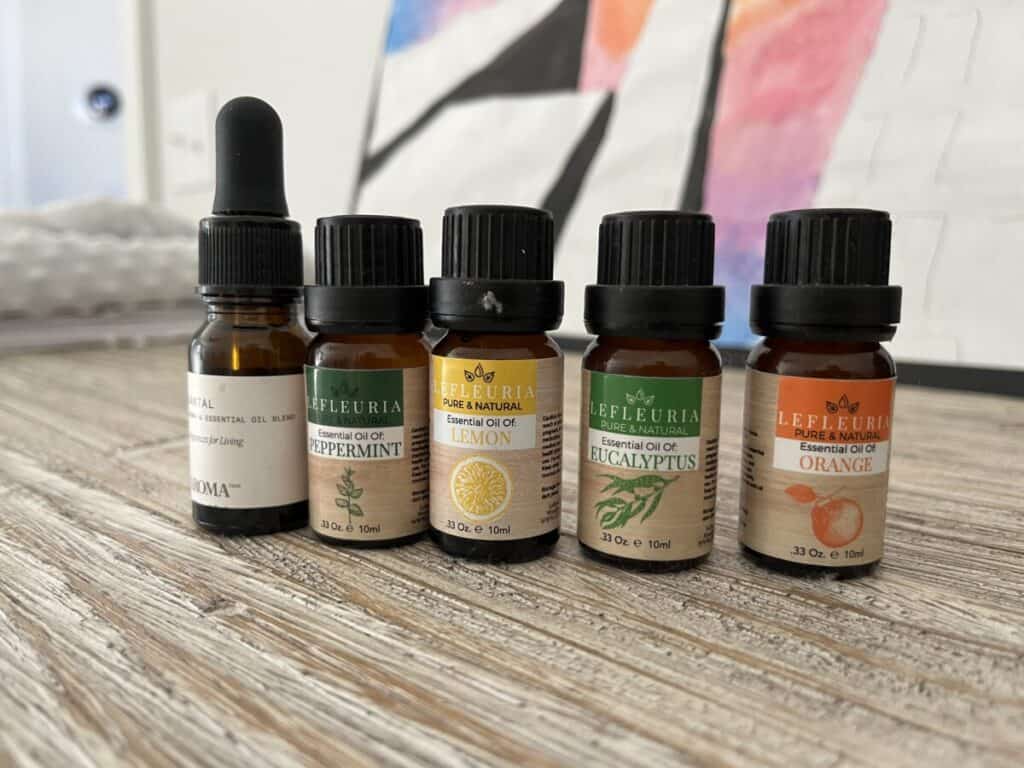
How Much Fragrance Oil Do You Put In a Reed Diffuser?
The quantity of fragrance oil you use in your reed diffuser oil recipe will depend on the purity of the oil and also the oil’s aroma throw or scent throw.
The scent throw is the measure of how well the oil’s scent circulates in the environment. Oils with higher scent throws can be used in a smaller quantity, whereas those with lighter or lower scent throws need to be used in large amounts.
I recommend starting with a ratio of 80% of carrier/base oil and 20% fragrance oil. For example, if you use an 80:20 ratio, then add around 168 ml of carrier/base oil and 42 ml of fragrance or essential oil to a bottle having a capacity of 250 ml.
Use this 80:20 ratio as a benchmark. Check how well the scent diffuses from your reed diffuser. If you want a more pungent/longer-lasting scent, increase the fragrance oil to 30% and reduce the carrier or base oil to 70%.
What is a Good Carrier Oil for Reed Diffusers?
The following carrier oils are ideal for mixing with essential oils to create a reed diffuser oil.
- Fractionated Coconut Oil
- Fractionated coconut oil is more liquid than solid compared to regular coconut oil.
- It is light.
- It does not have any odor/fragrance which makes it ideal for use with a reed diffuser.
MAJESTIC Pure Fractionated Coconut Oil
I recommend the MAJESTIC Pure Fractionated Coconut Oil for the following properties:
- It is versatile, does not stain, and has minimum odor. It has a light yellow color.
- Majestic Pure Fractionated coconut oil is also a great MCT oil (Medium Chain Triglycerides). Many people add MCT oil to their coffee to aid in weight loss.
- You can use it for cooking as well as for multiple beauty benefits like skin and hair.
- Safflower Oil
- Expeller-pressed safflower oil is very light which makes it great for aromatherapy essential oils.
- It has minimum odor.
- It is also heat-stable which makes it ideal for cooking, diffusing, etc.
Oléico High Oleic Safflower Oil
I recommend the Oléico High Oleic Safflower Oil for its following benefits:
- It is made with 100% high oleic safflower seeds.
- Oleico high-oleic safflower oil also contains Vitamin E.
- It is non-GMO.
- Sweet Almond Oil
- Sweet almond oil is one of the most popular carrier oils used in aromatherapy.
- It has a slightly nutty flavor and aroma.
- It is naturally enriched with Vitamin E.
NOW Solutions Sweet Almond Oil
I recommend the NOW Solutions Sweet Almond Oil for its following benefits:
- it is 100% pure and non-GMO.
- All NOW Solutions oils undergo PA A-rated GMP certification which means that they are extensively tested for stability and purity.
- Grapeseed Oil
- Grapeseed oil’s light satiny finish makes it exceedingly popular as aromatherapy oil and massage oil.
- It also offers therapeutic benefits like a sleep aid, stress relief, etc.
Pompeian 100% Grapeseed Oil
I recommend Pompeian 100% Grapeseed Oil for it has the following great features:
- It is light and subtle.
- Pompeian grapeseed oil also has high-heat stability and is non-GMO.
If you don’t have the time to make your own reed oil, go in for the readymade ones available in the market. Here are my top picks.
Best Reed Diffuser Oils
#1. Winner: Urban Naturals Reed Diffuser Oils
Urban Naturals Reed Diffuser oil is available in 32 different fragrances ranging from sage, mint, eucalyptus, rose, white tea, lemon verbena, cranberry pine, and so on.
The oils are carefully blended without chemicals, phthalates, parabens, alcohols, or other harsh chemicals. Urban Natural oils are also vegan and cruelty-free – which means they are not tested on animals.
The rattan wood reeds absorb the light oils and diffuse the fragrance throughout the room without any electricity or flames. You need only to invert the reed sticks every now and then.
Features
- 4 oz bottles
- Available in 32 fragrances
- Carefully crafted
- Long-lasting
- Made in the USA
Pros
- Vibrant fragrances with plenty of variety
- You can re-use the bottle and add your own DIY reed oils.
- 100% alcohol-free oil, vegan, cruelty-free
Cons
- Some scents aren’t quite as strong.
#2. Best Overall: Cocodor Reed Diffuser Oil
Cocodor oils meet the IFRA standards and are free from harsh chemicals. The brand was born in 2002, and since then, it has gained popularity worldwide as the manufacturer of fragrant essential oils, candles, etc.
Here are some of the top features of Cocodor Reed diffuser oil:
Features
- 6.7 oz bottles
- Compatible with all Cocodor reed diffusers
- Available in more than 10 fragrances
- Devoid of chemicals like trichloroethylene, didecyldimethylammonium chloride, toluene, xylene, and styrene
Pros
- Great scent
- Ideal for small spaces
Cons
- Dries out too quickly.
#3. Bonus: LOVSPA Fragrances
LOVSPA fragrances are available in 31 choices, so there is something for everyone. Their sandalwood/santal fragrance is especially popular. I loved its woodsy middle notes and citrusy top notes. The earthy, creamy aroma freshens up our bathroom and leaves one feeling fresh and invigorated.
Features
- 4 oz bottles
- 31 choices
- Comes with replacement reed sticks
Pros
- Easy to use
- Great variety in fragrances
- No watered down like other oils
Cons
- Only suitable for a very small area.
FAQs – Reed Oil Diffusers
Do oil reed diffusers work?
Reed oil diffusers work, but they may not be as powerful or effective as other types of diffusers. Also, they are suitable for small spaces only.
Are reed diffusers healthy?
Yes. Reed diffusers are healthy because you are not burning or heating the oil. The fragrance is mild, and you won’t be overwhelmed by the scent, unlike certain other diffusers. Always check the oil used in the diffuser and follow all other precautions that apply to essential oils.
Why can’t I smell my reed diffuser oil?
If you cannot smell the fragrance of your reed diffuser, you may want to invert or flip the reed sticks over so that their soaked portion is exposed to the air. Also, check if there is enough oil in the container and replace the oil if it has dried up. You can also try adding more reed sticks for a stronger scent.
Where should I place the reed diffuser?
Reed diffusers work best for small spaces like bathrooms, closets, etc. You can also place it in areas with high traffic and movement as moving air will help circulate the fragrance. However, never place the diffuser near an AC vent, in direct sunlight, or areas with draughts, as these tend to dilute the scent.
Conclusion – Reed Oil Diffusers: Can You Use Essential Oils?
Reed diffuser oil should not be used with electric or ultrasonic diffusers, and doing so could lead to fire hazards or electric short circuits.
Use the appropriate reed diffuser oils or make your own using carrier oils like sweet almond oil or safflower oil mixed with your favorite essential oil or fragrant oil. You can also use ready-to-use oils made especially for reed diffusers.

